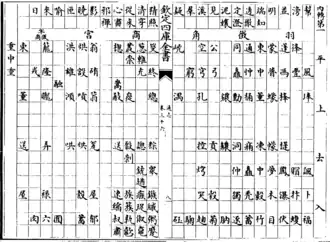
First table of the Qiyin lüe
The Qiyin lüe (Chinese: 七音略; pinyin: Qīyīn lüè; Wade–Giles: Chi-yin lüeh; lit. 'Seven Sounds Summary') is a Chinese rime table, which dates to before 1161. This reference work survived to the present largely because the Song dynasty historian Zheng Qiao (鄭樵/郑樵; Cheng Ch'iao; 1104–1162) included it in his 1161 encyclopedia Tongzhi.
The Chinese linguist Luo Changpei wrote a definitive study (1935) of the Qiyin lüe.[1] The structure and contents of the work is closely related to the Yunjing, and the two are believed to derive from a common source prior to the Song dynasty.[2] Both have tables combining rows for a particular final rime, columns for various initials, and up to four tones.
See also
References
- ↑ Luo, Changpei (1935). "Tōngzhì Qīyīn lüè yánjiū" 通志七音略研究 [Research on the Tongzhi Qiyun lue]. Bulletin of the Institute of History and Philology, Academia Sinica (in Chinese). 5: 521–536.
- ↑ Baxter, William H. (1992). A Handbook of Old Chinese Phonology. Trends in Linguistics: Studies and Monographs. Vol. 64. Berlin and New York City: Mouton de Gruyter. pp. 41–42. ISBN 978-3-11-012324-1.
External links
Wikimedia Commons has media related to Qiyin lüe.
- parts 34–36 and 37–38 of the Tongzhi encyclopedia at the Internet Archive – the Qiyin lüe comprises parts 36 and 37
- Rhyme Tables, Dylan W.H. Sung
This article is issued from Wikipedia. The text is licensed under Creative Commons - Attribution - Sharealike. Additional terms may apply for the media files.